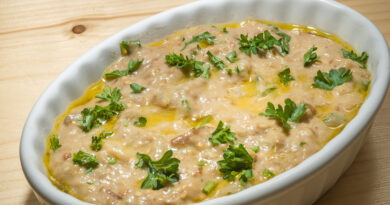Toum
Toum: Unveiling the Magic of Lebanese Garlic Sauce
Introduction:
In the world of Middle Eastern cuisine, where flavors are bold and aromatic, one condiment reigns supreme, adding a garlicky kick to dishes and tantalizing taste buds—Toum. This Lebanese garlic sauce, known for its creamy texture and intense garlic flavor, has transcended borders and become a global favorite. Join us on a flavorful journey as we explore the origins, preparation methods, and culinary versatility of Toum, celebrating the magic of this iconic sauce.
Origins and Culinary Roots: Tracing the Legacy of Toum
Lebanese Heritage:
Toum, which translates to garlic in Arabic, is deeply rooted in Lebanese culinary traditions. Originating from the Levant region, particularly Lebanon, this sauce has been a staple in the region for centuries, enriching the flavor profiles of various dishes.
Traditional Significance:
Toum holds cultural significance in Lebanese households, often prepared during festive occasions, family gatherings, and celebratory meals. Its presence on the dining table symbolizes the richness of Lebanese gastronomy and the art of bringing people together through shared meals.
Ingredients and Preparation: Crafting the Elixir of Garlic Lovers
Main Ingredients:
- Garlic: The star of the show, garlic is the key ingredient in Toum, providing its distinctive flavor and aromatic intensity.
- Oil: Typically, neutral-flavored oils like vegetable or sunflower oil are used to create the creamy texture of Toum.
- Lemon Juice: Freshly squeezed lemon juice adds a tangy and citrusy element, balancing the richness of the garlic and oil.
- Salt: To enhance the flavors and provide the necessary seasoning for the sauce.
Preparation Method:
- Peeling and Crushing Garlic: Fresh garlic cloves are peeled and crushed to release their potent aroma and essential oils.
- Emulsification Process: The crushed garlic is blended with oil in a slow, steady stream to create an emulsion. This process requires patience and precision to achieve the desired creamy consistency.
- Incorporating Lemon Juice: Fresh lemon juice is gradually added to the emulsion, providing acidity and enhancing the overall flavor profile.
- Seasoning with Salt: The final touch involves seasoning the Toum with salt, striking a harmonious balance between the garlic, oil, and citrus elements.
Culinary Versatility: Toum as a Flavor Enhancer
Classic Pairings:
- Shawarma and Kebabs: Toum is a classic accompaniment to grilled meats, shawarma, and kebabs, adding a garlicky kick that elevates the savory notes of the dishes.
- Falafel and Fries: Often served with falafel and as a dipping sauce for fries, Toum brings a burst of flavor and creaminess to these popular street foods.
- Roasted Vegetables: Toum pairs well with roasted vegetables, offering a vibrant and zesty contrast to the sweetness of caramelized flavors.
Sandwiches and Wraps:
- Chicken and Beef Wraps: Toum is a popular choice in Middle Eastern wraps and sandwiches, providing a flavorful spread that enhances the overall taste.
- Vegetarian Options: For those opting for vegetarian or vegan options, Toum serves as a versatile and tasty condiment to complement plant-based sandwiches and wraps.
Toum in Lebanese Festivities: A Culinary Tradition
Weddings and Celebrations:
In Lebanon, Toum is often present during joyous occasions like weddings and celebrations. Its inclusion in festive feasts symbolizes abundance, prosperity, and the joy of communal dining.
Family Gatherings:
During family gatherings and Sunday meals, Toum takes center stage, turning ordinary dishes into extraordinary culinary experiences. Its presence is a testament to the love and care put into preparing meals for loved ones.
Culinary Rituals:
The act of making Toum is often passed down through generations, becoming a culinary ritual that connects families to their Lebanese heritage. The sharing of recipes and techniques ensures the preservation of this flavorful tradition.
Homemade Toum vs. Commercial Variants: Exploring the Options
Homemade Charm:
Many Lebanese families take pride in crafting their own Toum at home, showcasing the personal touch and dedication that goes into preparing this garlic sauce. Homemade Toum often boasts a fresher and more authentic flavor.
Store-Bought Convenience:
As the popularity of Toum has grown globally, commercial versions have become widely available. While convenient, these pre-packaged options may vary in flavor and intensity compared to homemade varieties.
Culinary Trends: Toum in the Modern Kitchen
Fusion Cuisine:
Chefs and home cooks around the world are experimenting with Toum, infusing it into various cuisines and culinary styles. Its creamy texture and bold flavor make it a versatile ingredient for creative culinary expressions.
Toum-Inspired Dishes:
From Toum-infused pasta sauces to Toum-marinated proteins, the sauce has inspired a range of dishes that showcase its adaptability and appeal to diverse palates.
Conclusion: Toum – A Culinary Symphony of Garlic and Culture
Toum is more than just a condiment; it is a culinary journey through the flavors, traditions, and heart of Lebanese cuisine. Its ability to elevate dishes, bring people together, and symbolize joy makes it a true icon of Middle Eastern gastronomy.
As we savor the creamy texture and robust garlic notes of Toum, we partake in a tradition that spans generations and connects us to the rich cultural heritage of Lebanon. Whether enjoyed on a shawarma wrap, alongside a plate of grilled meats or as a versatile ingredient in modern dishes, Toum stands as a testament to the magic that can be found in the simplest of ingredients—a true culinary symphony that resonates with garlic lovers around the world.



